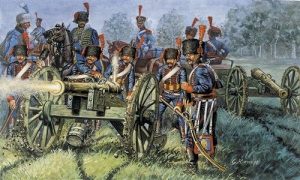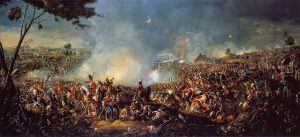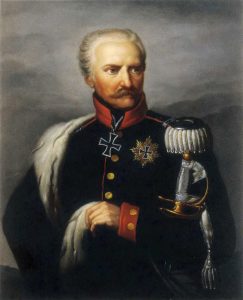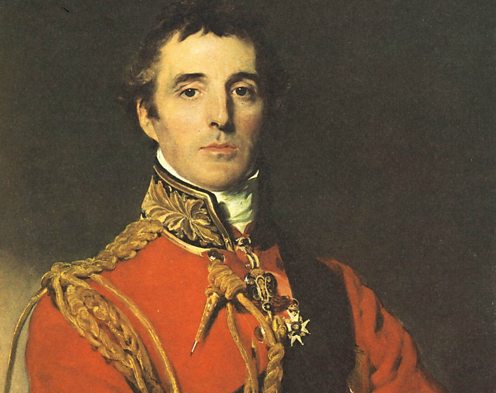 The Battle of Waterloo changed everything.
The Battle of Waterloo changed everything.
I’ve just made that statement with a snigger, knowing that dozens of historians out there will take a deep breath, their eyes gleaming as they get ready to launch themselves into the fray with the enthusiasm of a pack of hounds who’ve been cooped up during a twelve year ban on fox hunting. Some of them will argue that the Battle of Waterloo was of no real significance since Europe was in transition anyway. Others will say that while the campaign was important, the battle itself made no significant difference as even if Napoleon had defeated Wellington and Blucher he would then have had to face the Austrians and Russians. Some will say that the battle should never have happened, that the European powers could have negotiated with Bonaparte whose power was much reduced, and that Europe would have done better with him left in charge of France than the Bourbons. Others will get so excited arguing whether the battle was actually won by Wellington or Blucher and how many of each nationality were involved in the various armies, that they’ll forget what the original question was about.
I’d love to be in the middle of that argument; far more so than any of the current spiteful squabbling about Theresa May, Jeremy Corbyn, Brexit and who actually won the election (count the votes, it gives an enormous clue regardless of who we might have wanted to win). There is something about a good historical scrap which I thoroughly enjoy.
 The Battle of Waterloo was fought on Sunday, 18 June 1815 in Belgium which was then part of the United Kingdom of the Netherlands. A French army under the command of Napoleon Bonaparte was defeated by two of the armies of the Seventh Coalition: an English-led Allied army under the command of the Duke of Wellington, and a Prussian army under the command of Gebhard Leberecht von Blücher, Prince of Wahlstatt.
The Battle of Waterloo was fought on Sunday, 18 June 1815 in Belgium which was then part of the United Kingdom of the Netherlands. A French army under the command of Napoleon Bonaparte was defeated by two of the armies of the Seventh Coalition: an English-led Allied army under the command of the Duke of Wellington, and a Prussian army under the command of Gebhard Leberecht von Blücher, Prince of Wahlstatt.
 Upon Napoleon’s return to power in March 1815, many states that had opposed him formed the Seventh Coalition, and began to mobilize armies. Wellington and Blücher’s armies were situated close to the north-eastern border of France and Bonaparte needed to attack and attack fast before the rest of the coalition could join them. The days of the Grande Army were long gone. Bonaparte had landed from Elba with a tiny force although he was picking up troops far more quickly than anybody had expected. Still many of his men were new recruits without the training and discipline of his armies of old, and he needed to buy time to bring them up to scratch. If he could defeat the English and Prussian armies he might be able to negotiate a temporary peace which would give him some time.
Upon Napoleon’s return to power in March 1815, many states that had opposed him formed the Seventh Coalition, and began to mobilize armies. Wellington and Blücher’s armies were situated close to the north-eastern border of France and Bonaparte needed to attack and attack fast before the rest of the coalition could join them. The days of the Grande Army were long gone. Bonaparte had landed from Elba with a tiny force although he was picking up troops far more quickly than anybody had expected. Still many of his men were new recruits without the training and discipline of his armies of old, and he needed to buy time to bring them up to scratch. If he could defeat the English and Prussian armies he might be able to negotiate a temporary peace which would give him some time.
Realistically it was a faint hope. There had been so many attempts to make peace with Bonaparte, it is hard to believe that the powers of Europe seriously considered it. Wellington certainly did not. He wanted to fight and he wanted to fight on his terms and on his ground. Scrabbling together an army was not easy. His veteran Peninsular troops were scattered, some having been sent to America. Many of the European troops under his command were raw and untrained and he had little time. But he had already scouted his battlefield while on a tour of defences and he was hoping he could make the best use of it.
Napoleon successfully attacked the bulk of the Prussian army at the Battle of Ligny with his main force, while at the same time a portion of the French army attacked an Allied army at the Battle of Quatre Bras. Despite holding his ground at Quatre Bras, the defeat of the Prussians forced Wellington to withdraw to Waterloo. Napoleon sent a third of his forces to pursue the Prussians, who had withdrawn parallel to Wellington. This resulted in the Battle of Wavre with the Prussian rear-guard.
 Upon learning that the Prussian army was able to support him, Wellington decided to offer battle on the Mont-Saint-Jean escarpment, across the Brussels road, the terrain he had already scouted previously. There had been no reason for Wellington to be searching out battle sites; his tour of the defences of the low countries was actually probably a way of getting him away from Paris for a time given his enormous unpopularity there. There were threats of assassination and Wellington was refusing to run away, so his timely visit to Belgium was a way to remove him from danger. But for a general whose eye for terrain was one of his greatest assets, the low ridge of Mont-Saint-Jean, south of the village of Waterloo and the Sonian Forest, with it’s selection of farms acting as bastions along the wall of the ridge, the advantages of the site were hard to miss.
Upon learning that the Prussian army was able to support him, Wellington decided to offer battle on the Mont-Saint-Jean escarpment, across the Brussels road, the terrain he had already scouted previously. There had been no reason for Wellington to be searching out battle sites; his tour of the defences of the low countries was actually probably a way of getting him away from Paris for a time given his enormous unpopularity there. There were threats of assassination and Wellington was refusing to run away, so his timely visit to Belgium was a way to remove him from danger. But for a general whose eye for terrain was one of his greatest assets, the low ridge of Mont-Saint-Jean, south of the village of Waterloo and the Sonian Forest, with it’s selection of farms acting as bastions along the wall of the ridge, the advantages of the site were hard to miss.
Bonaparte was outnumbered in Europe; 250,000 Frenchmen faced a coalition of about 850,000 soldiers on four fronts. Napoleon was forced to leave 20,000 men in Western France to reduce a royalist insurrection. Six days before Napoleon reached Paris, the powers at the Congress of Vienna had declared him an outlaw and the United Kingdom, Russia, Austria, and Prussia mobilised armies against him. Napoleon knew that his only chance of remaining in power was to attack before the coalition had time to mobilise.
Had Napoleon succeeded in destroying the existing coalition forces south of Brussels before they were reinforced, he might have been able to drive the British back to the sea and knock the Prussians out of the war. Crucially, this would have bought him time to recruit and train more men before turning his armies against the Austrians and Russians. He also hoped that a French victory might cause French speaking sympathisers in Belgium to launch a revolution. In addition, coalition troops in Belgium were largely second-line, as many units were of dubious quality and loyalty, and most of the British veterans of the Peninsular War had been sent to North America to fight in the War of 1812.
His strategy was simple; to isolate the Allied and Prussian armies and annihilate each one separately. Wellington hoped to counter the threat by moving through Mons to the south-west of Brussels, bringing him closer to Blücher, but there was a risk of cutting communications with his base at Ostend, and Wellington’s Peninsular experience had taught him the importance of supply lines.
By June, Napoleon had raised an army of about 300,000 men. The force at his disposal at Waterloo was less than one third that size, but the rank and file were nearly all loyal and experienced soldiers unlike Wellington’s army which was cobbled together. Bonaparte divided his army into a left wing commanded by Marshal Ney, a right wing commanded by Marshal Grouchy and a reserve under his command. Crossing the frontier near Charleroi before dawn on 15 June, the French rapidly overran Coalition outposts, securing a central position between Wellington’s and Blücher’s lines.. He hoped this would prevent them from combining, and he would be able to destroy first Blucher’s army, then Wellington’s.
In the early hours of 16 June, at the Duchess of Richmond’s ball in Brussels, Wellington received a dispatch from the Prince of Orange confirming that the Charleroi approach was to be Bonaparte’s main thrust and he was shocked by the speed of Napoleon’s advance. He hastily ordered his army to concentrate on Quatre Bras, where the Prince of Orange was holding a tenuous position against the soldiers of Ney’s left wing.
Ney’s orders were to secure the crossroads of Quatre Bras, so that he could later swing east and reinforce Napoleon if necessary. Ney found the crossroads of Quatre Bras held by the Prince of Orange, who repelled Ney’s initial attacks but was gradually driven back by overwhelming numbers of French troops. First reinforcements, and then Wellington arrived. He took command and drove Ney back, securing the crossroads too late to send help to the Prussians, who had already been defeated by Napoleon at the Battle of Ligny using part of the reserve and the right wing of his army. The Prussian centre gave way under heavy French assaults, but the flanks held their ground and the Prussians managed to retreat from Ligny uninterrupted by the French.
 Crucially, the Prussians did not retreat to the east, along their own lines of communication. Instead, they, too, fell back northwards—parallel to Wellington’s line of march but still within communication with the English commander. The Prussians rallied on Bülow’s IV Corps, which had not been engaged at Ligny and was in a strong position south of Wavre and Blucher, although wounded, held himself ready to go in support of Wellington.
Crucially, the Prussians did not retreat to the east, along their own lines of communication. Instead, they, too, fell back northwards—parallel to Wellington’s line of march but still within communication with the English commander. The Prussians rallied on Bülow’s IV Corps, which had not been engaged at Ligny and was in a strong position south of Wavre and Blucher, although wounded, held himself ready to go in support of Wellington.
With the Prussian retreat from Ligny, Wellington’s position at Quatre Bras was impossible and he withdrew northwards, to the defensive position he had reconnoitred the previous year—the low ridge of Mont-Saint-Jean just south of Waterloo. On 17th June the armies prepared to give battle.
My series of novels set during the Peninsular War is well underway with the first four books published. I am halfway through the fifth and I have the rest planned out so I know where my characters are going to be at the Battle of Waterloo and I know roughly what is going to happen to them. It’s going to be emotional when I finally get there.
For the men of Wellington’s army who did fight at the Battle of Waterloo, it must have felt very much like a life changing event whatever the historians might say. The battle itself was bloody with enormous losses to death and injury on both sides, but more than that, these men had believed it was all over. The officers of the 110th had gone home to friends and family after five or six long years in the field. The powers of Europe had celebrated for weeks in London and the Bourbons had been restored.
Suddenly it must have seemed as though they had it all to do again. Men who thought they had made it, with their friends and comrades through the long years of war had to fight again and some of them would probably die.
 For the men of the 110th light infantry and the women who loved them it probably would have seemed like a nightmare. For a historical novelist in search of a dramatic plot line, it’s a bit of a gift.
For the men of the 110th light infantry and the women who loved them it probably would have seemed like a nightmare. For a historical novelist in search of a dramatic plot line, it’s a bit of a gift.
Back soon with the rest of the story of the Battle of Waterloo…

